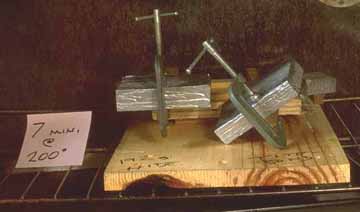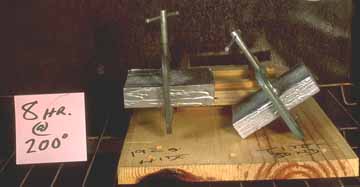Aliphatic resin gives me the creeps!
Heat Testing Glue Joints
© Frank Ford, 4/25/98; Photos by FF, 1997
I'd heard so much discussion about the various qualities of glue joints that I finally
decided to do a little testing of my own. As you may know, my goal is to make luthiers
aware of the tendency of aliphatic resin and white glue (I tend to use Titebond as
a generic term) to creep under even mild heat.
My testing methods were not as precisely controlled as I might want before publishing
a monograph in Fine Woodworking, but I think I got some pretty clear results.
I glued and clamped a plain lap joint in some clear heart redwood. In all the samples
the joint measured the same length and width. Then I made up a very simple testing
fixture which held the joint vertical as I loaded the end with lead bricks. I have
these lead bricks which weigh in at about 3 lb. each, so I simply clamped one on
to the end of each stick:

Pretty simple, eh?
I tested the samples at room temperature and found that if I loaded seven pounds
on each, the joints would break immediately, splitting off wood fully across the
face of the joint. I'll talk more about that shortly.
OK, on to the heat stress test. My kitchen oven's lowest setting
is very nearly 200 degrees Fahrenheit, so I chose that for my test. When I can sometime,
I'll run this test at about 150 degrees. I used a good standard thermometer to calibrate
my oven setting over a couple of hours, so I'd be sure it was very close to 200 degrees
for the test.
I opened up the door, slipped in my fixture, and waited. In only a few minutes I
heard a loud "clunk" as one of the weights hit the board:

Within seven minutes the Titebond joint failed utterly and cleanly. (By the way,
I did repeat this test with the same results.)
Then I figured I'd measure how long the hide glue would take to fail at 200 degrees:

That's right, it didn't. After waiting all day (Mind you, I was doing other things)
I finally couldn't stand it and had to try a higher temperature, so I cranked the
oven up. I had to stop the test with an oven setting of 375 degrees because the wood
charred and my smoke detector went off!
So you could say that hide glue resists heat better that Titebond and its aliphatic
cousins.
But if hide glue doesn't melt at 375 degrees, then how come you can take joints apart
with heat? Well, I think it works like this: If you're stressing the joint nearly
to the breaking point, then hide glue gives up in heat as well. There are no joints
that are under this stress in a normal stringed instrument, because just the slightest
touch and they'd explode.
When we're prying joints apart, we're stressing the immediate area to the max, and
if heat is applied, then hide glue joints will part.
I repeated my test just like above but loaded the joints with two bricks each. All
it would take is a tiny bit more and the joint would break even while cold. In fact,
I had to be very careful in setting the board down on the oven shelf because a slight
bump would cause the joints to break. That happened twice as I was running my tests.
Within 5-7 minutes, both joints failed. In fact they failed at nearly the same time.
Look at the results:

Titebond failed utterly and cleanly. The hide glue joint started to lose a little
strength and then the wood broke. The joints looked the same each time I repeated
the test.
I felt I learned that hide glue in normal joint will stand up to heat so much better
that the commonly used Titebond aliphatic resin that I've really become a crusader
for the use of hide glue in highly sensitive stressed joints.
Particularly, I'm interested in the fingerboard and bridge joints. Bridges pull off
with added heat, and fingerboards creep a little causing serious neck warping, especially
on mandolins where the string tension is very high and the gluing area is small.
By the way, 200 degrees is not that far from the heat of the inside of a car parked
in the sun. My Nissan hatchback could easily make it to 175 within fifteen minutes.
If you think that all musicians avoid leaving their instruments in parked cars, then
you are thinking wrong!
How's that for a strong statement?
I'd better stop before I get into more trouble. . .
Back to Index Page